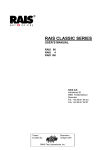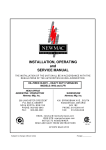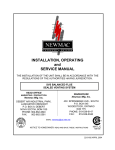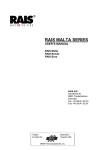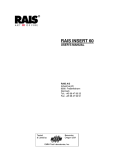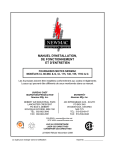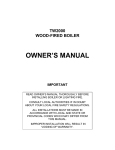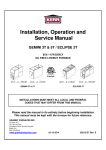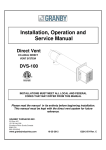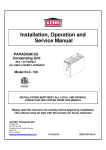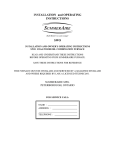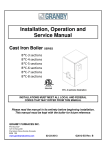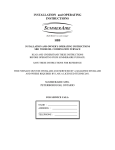Download HP DB-102 User's Manual
Transcript
SCOTTY WOOD FURNACE Model DB-102 OWNER’S MANUAL IMPORTANT READ OWNER’S MANUAL THOROUGHLY BEFORE INSTALLING FURNACE OR LIGHTING FIRE. CONSULT LOCAL AUTHORITIES IF IN DOUBT ABOUT YOUR LOCAL FIRE SAFETY REGULATIONS. ALL INSTALLATIONS MUST BE MADE IN ACCORDANCE WITH LOCAL AND STATE OR PROVINCIAL CODES WHICH MAY DIFFER FROM THIS MANUAL. IMPROPER INSTALLATION WILL RESULT IN VOIDING OF WARRANTY. SCOTTY WOOD FURNACE – INSTRUCTION MANUAL TABLE OF CONTENTS 1.0 Specifications 3 Operating Instructions 4 4 4 5 6 6 6 7 7 7 8 9 1.1 1.2 1.3 1.4 1.5 1.5.1 1.5.2 1.6 1.7 1.8 1.9 2.0 Introduction Wood-Burning Storage of Wood Maximum Solid-Fuel Charge Maintenance Cleaning Servicing Safety Controls Electrical Power Failure Homeowner Checklist Installation Instructions 2.1 2.2 2.3 2.4.1 2.4.2 2.5 2.6 2.7 2.8 2.9 9 9 10 10 11 11 12 13 14 14 15 Introduction to Installers Uncrating Locating the Furnace Combustion Air Supply Flue Pipe & Chimney Clearances Duct Connection Free Standing Control System Installers Checklist DIAGRAMS S102 – 1 S102 – 2 S102 – 3 S102 – 4 S102 – 5 S102 – 6 S102 – 7 Clearances Combustible Floor Base Control Placement Detail Free Standing Wiring Diagram Control Placement Cleaning Ductwork Configurations Appendices APPENDIX A – Warranty Scotty Rear Cover 2 Oct-06 SCOTTY WOOD FURNACE – INSTRUCTION MANUAL KERR SCOTTY Wood Furnace Model DB-102 Certified by the Canadian Standards Association Manufactured by: Parrsboro Metal Fabricators Ltd. P.O. Box 637, Crossroads 12118, Highway 209 Parrsboro, Nova Scotia, Canada B0M 1S0 SPECIFICATIONS Length Width Height Shipping Weight Fire Box 1/8”plate 46 1/2” 22 1/2” 43” 344 lb 27 1/2” 18” 14 gauge steel 12” x 12” 29” x 20 3/4” 14 ½” x 20 3/4” 16” x 20” x 1” G9 – 10 1/4 hp 1000 (Required) 7” Inside Diameter 36” 70,000 Btu/h Wood 24” logs Volts 120, Cycles 60, Amps 15 Length Diameter Secondary Heat Exchanger Fire Box Door Cast Iron Warm Air Plenum Return Air Plenum Air Filter Size Blower Size Blower Motor CFM Smoke Pipe Floor to smoke pipe center Output (max) Fuel Electrical Rating NOTE – Keep this manual in a safe place for future reference. Follow manual carefully for the correct way to install and operate this unit. CAUTION – Do not fire this unit until operating instructions have been read and fully understood. INSTALL WOOD FURNACE ONLY ON A FURNACE DUCT SYSTEM AND CHIMNEY THAT ARE IN GOOD CONDITION AND APPROVED FOR USE. SAVE THESE INSTRUCTIONS Scotty 3 Oct-06 SCOTTY WOOD FURNACE – INSTRUCTION MANUAL 1.0 OPERATING INSTRUCTIONS 1.1 INTRODUCTION Congratulations on your purchase of the KERR SCOTTY Wood Furnace. Developed in Atlantic Canada, this KERR Furnace has been designed to allow you to heat your home with wood, one of North America’s most abundant fuels. Designed with you in mind, the KERR SCOTTY Wood Furnace will provide you with many years of safe, efficient central heating. To ensure you have a clear understanding of the operating procedures of this furnace, please take the time to read the remainder of this section on operating procedures. If you have any questions, your KERR DEALER will be happy to answer them for you. 1.2 WOOD-BURNING The SCOTTY Wood Furnace will burn most wood fuels, however it is recommended that only dry, seasoned hardwood be used as much as possible since it affords cleaner, safer and more efficient operation. Burning seasoned hardwood will leave less ash, soot and creosote residue and will require fueling less often. Use smaller loads of wood on warmer days. WARNING: DO NOT use chemicals or fluids to start the fire or during operation. DO NOT burn driftwood or manufactured logs (compressed wood). Before adding fuel to an existing fire turn up the thermostat for about five minutes or lift damper chain to hold damper fully open for about one minute before opening the loading door. This action will allow residual smoke to clear from the combustion chamber and reduce smoke entering the basement during refueling. Twice daily refueling may be sufficient in modern well-insulated homes. However, KERR recommends that small fuel loads be added morning, noon and early evening and late evening, rather than large quantities infrequently. A small intense fire will burn more efficiently than a large smoldering fire in the SCOTTY Wood Furnace and will produce less creosote. When refueling the SCOTTY, the remaining coals should be raked to the front of the combustion chamber before adding any new fuel. Place the fresh supply of wood to the rear of the combustion chamber. This gives more of an even cigar type fuel burn, rather than a large hot fire to a slow amber fire. This will help create a more even and efficient burn. The SCOTTY owner should attempt to gauge fuel quantities with outdoor temperatures; a little practice will provide greater satisfaction and efficiency. WARNING: This furnace is not to be used with an automatic stoker. Keep firing door tightly closed and maintain door seal in good condition. Scotty 4 Oct-06 SCOTTY WOOD FURNACE – INSTRUCTION MANUAL CREOSOTE Wood combustion is never 100% complete. Wood smoke always contains unburned gases and a mixture of unburned tar-like liquids. A percentage of materials will condense out on any cool surface, leaving a dark brown or substance with an unpleasant acrid odour. This substance is commonly creosote. some these black called These wood gases condense out on cool surfaces such as a cold chimney or a long smoke pipe; they retain large amounts of water and will be very fluid. At higher temperatures the condensed creosote will resemble tar (thick and tacky). Creosote generation is highest during low heat outputs common with long smoldering burns. Creosote generation is lowest during high heat outputs common with intense fires. It is recommended that a small intense fire be used for best results against creosote build up even though the wood furnace will require refueling more often. Creosote generation is also higher when burning green wood. The moisture in the green wood absorbs the heat from the fire, cooling the fire below the point at which the creosote can be consumed. The low temperature smoke is then further cooled in the upper furnace chambers’ smoke pipe and chimney allowing large amounts of creosote to form. To reduce creosote build-up during periods of low heat requirements (i.e. Spring and Fall) it is recommended to fuel the wood furnace with smaller quantities of smaller diameter logs. Matching fuel loads and heat requirements will generally result in cleaner combustion and higher efficiency. IN CASE A SERIOUS CREOSOTE FIRE BEGINS: a) Close the damper door by disconnecting chain b) Close all draft regulators c) Throw 1/2 lb of coarse or table salt on the fire and close door immediately. d) Call the FIRE DEPARTMENT at once! Have a firmly established Emergency Procedure in place for the handling of a flue fire. 1.3 STORAGE OF WOOD Once cut, green wood dries (or seasons), quickly at first and then at a slower and slower rate. When the wood has been cut to the proper length and split, it should be piled outside during the summer months. Place two poles on the ground to serve as rails to keep the firewood off the moist ground. Stack the wood so that both ends of the logs are exposed to the air if space is available, since more drying occurs through the cut ends than through the sides. This is true even with wood that has been split. The woodpile should be under cover so that it will not absorb moisture from the rain and snow before it is used, but still open on the sides and ends to the drying effect of the wind and sun. Store wood in neat, well-supported piles. Scotty 5 Oct-06 SCOTTY WOOD FURNACE – INSTRUCTION MANUAL 1.4 MAXIMUM SOLID-FUEL CHARGE The maximum level for a solid-fuel charge is the middle of the loading door, or the level of the handle. DO NOT OVERFILL. The KERR SCOTTY Wood Furnace will accept whole or split logs up to 27 in. (686 mm) long, but a 24 in (610 mm) log length is recommended for convenience and ease in handling. Maximum damper gate opening is 11/16”. Do not tamper or adjust to greater opening in an attempt to increase fire or over-firing and hazard may result. 1.5 MAINTENANCE Some regular maintenance is necessary on the KERR SCOTTY furnace. A good practice is to establish a routine for the storage of fuel, care of the appliance, and firing techniques. 1.5.1 CLEANING (Fig S102-6) The KERR SCOTTY Wood Furnace must be cleaned regularly to maintain top efficiency. The furnace needs cleaning more often when burning green wood, or during long periods of low fire. When the KERR SCOTTY Wood Furnace is first installed the furnace heat exchanger should be checked visually from the firebox and smoke pipe hole every week to determine the rate at which creosote or ash is accumulating within the furnace. Cleaning should be done whenever there is more than 1/4 inch of build-up on the heat exchanger or 3 inches of ash in the base. If the wood furnace is to be left unused for an extended period of time (more than one month) then the appliance should be cleaned of all ash and residual left from the burning of wood. See fig. S102-6 CLEANING PROCEDURE: 1) Make sure fire is completely out and the furnace has cooled. 2) Remove the smoke pipe located on the rear of the furnace heat exchanger. 3) The heat exchanger is now accessible for cleaning. 4) Use the scraper provided to remove all soot and ash from the furnace heat exchanger and exposed surfaces. 5) Scrape all residues in the top heat exchanger towards the front of the furnace where it will fall into the firebox. 6) Always check flue pipe for creosote or ash build-up in the pipe and clean if necessary. 7) Reinstall smoke pipe making sure that all joints are secured with at least 3 sheet metal screws. 8) Check chimney cleanout for ash build-up and remove any accumulation. 9) Residue may be removed from the firebox or left to be burnt during the next fire. It is good practice to leave a layer of ash approximately one inch deep in the base of the firebox. Scotty 6 Oct-06 SCOTTY WOOD FURNACE – INSTRUCTION MANUAL DISPOSAL OF ASHES Ashes should be placed in a metal container with a tight fitting lid. The closed container of ashes should be placed on a non-combustible floor or on the ground, well away from all combustible materials, pending final disposal. If the ashes are disposed of by burial in soil or otherwise locally dispersed, they should be retained in the closed container until all cinders have thoroughly cooled. WARNING – Ashes usually contain live dormant coals, which may burn for many hours after a recognizable flame has disappeared. Use extreme caution when handling and disposing ashes. IMPORTANT – No other waste shall be placed in this container. 1.5.2 SERVICING The furnace air filter must be checked monthly and replaced each year. Annually lubricate the blower motor, if it is not permanently lubricated, with 4-6 drops of SAE-30 oil in each bearing. CAUTION: Failure to keep air filter clean will result in poor furnace performance and possible damage to wood furnace heat exchanger. 1.6 SAFETY If the furnace overheats due to improper operation the following precautions should be taken: 1) DO NOT shut off power. The blower must be kept running to disperse excessive heat. 2) Manually close the damper door by unhooking the chain. 3) Check controls for proper operation before starting a new fire. WARNING – The maximum opening of the combustion air damper is preset at the factory. DO NOT adjust the stop or attempt to increase the combustion air by any means. 1.7 CONTROLS (Fig S102-3) Thermostat The primary control is the room thermostat located near the center of the house on the main floor or near an existing thermostat. The thermostat operates the damper motor to open and close the damper door thus allowing more or less air into the combustion area to control the fire. Fan & Limit The fan and limit control mounted in the plenum controls the operation of the circulating blower and prevents the furnace from over-heating. When the air temperature in the plenum reaches the “ON” set point of the fan switch (usually 140º F (60º C)) the blower starts and runs until the plenum cools to the “OFF” set point (usually 100º F (38º C)) when the blower is switched off. The limit function in this control is usually set at (250º F (121º C)) and will override the room thermostat to close the damper door if the furnace overheats, and will also prevent the oil furnace from starting. Scotty 7 Oct-06 SCOTTY WOOD FURNACE – INSTRUCTION MANUAL 1.8 ELECTRICAL POWER FAILURE If no one is home during a power failure, the damper will automatically close and some gravity heating will take place. Combustion air will continue to enter through the secondary air holes and a fire should be maintained. IMPORTANT – This furnace is CSA certified for operation under Power Failure only if the following procedure is followed. For optimum heating during a power failure follow the procedure listed below: 1) Manually open the blower compartment access door of the wood furnace to allow gravity flowing air to all areas. (Check with your installer) 2) Place a coin under the damper flap in such a way that it will fall clear when power is restored. 3) Maintain a careful watch on the furnace temperature. If it should exceed 200º F (95º C) close the damper door. 4) Do not leave the furnace unattended in this position. 5) Refuel frequently with small load to maintain a small fire at 1/2 normal maximum volume. 6) Do not expect to maintain maximum comfort under no power conditions. 7) Do not allow anyone who is unfamiliar with the operation of the furnace to attend it during a power failure. Scotty 8 Oct-06 SCOTTY WOOD FURNACE – INSTRUCTION MANUAL 1.9 HOMEOWNER CHECKLIST o Keep area around unit clean and clear of combustibles. o Use only dry wood. DO NOT burn garbage, gasoline or naphtha. o Load carefully. o Remove ashes as directed. o Watch for soot in smoke pipe – clean regularly. o Clean furnace heat exchanger regularly. o Be aware of danger due to over firing unit. o Do not load above maximum loading level (middle of loading door) or overheating may result. o This unit is NOT suitable for automatic stoking. o Load carefully. Do not slam fuel against rear or sides of firebox. This may damage the firebox. o Always observe the following minimum clearances to combustible materials – Front 48” (1220 mm); one side 6” (152 mm); opposite side and rear 24” (610 mm); and flue pipe 18” (465 mm). o Do not store solid fuel within the above clearances or within the space required for charging and ash removal. o Establish a routine for storage of fuel, care of the appliance, and firing techniques. 2.0 INSTALLATION INSTRUCTIONS 2.1 INTRODUCTION TO INSTALLERS Before installing this KERR SCOTTY Wood Furnace, please read the following instruction manual carefully. This unit is designed as a freestanding or add-on central heating furnace to provide complete central heating in medium sized well-insulated homes. Before installing be sure unit is properly sized for the intended application. Warranty does not cover misapplication of unit. Applicable Standards The KERR SCOTTY Wood Furnace must be installed in accordance with the requirements of the National Fire Protection Association codes, the Canadian Heating, Ventilation and Air Conditioning Code, The National Board of Fire Underwriters, and the CSA Standards for solid fuel burning equipment as outlined in B365. In all cases consult your local authorities and fire insurance company for specific regulations. Scotty 9 Oct-06 SCOTTY WOOD FURNACE – INSTRUCTION MANUAL 2.2 UNCRATING When you receive your KERR SCOTTY Wood Furnace, check it carefully to ensure that all components are present and in good condition. If there has been any damage or loss in transportation, please notify the carrier and retailer at once. Inspect for the following: o o o o Firebox/Heat exchanger Poker/coals rake Marking template (return air and power failure bypass inlet) For free-standing model optional equipment required: a) Control Kit “B” (SCOTTY only) CONTROL KIT B (free-standing) that includes: o L4064R Fan and Limit Control o Control Mounting Plate o Damper Motor o Thermostat (T822D or equivalent) o Wiring Harness and Parts o Transformer– Kit “B” only NOTE: Some parts may be packed inside furnace firebox. Check shipment carefully before assuming shortage. 2.3 LOCATING THE FURNACE (Fig S102-2) The location of the furnace must be as close as possible to the chimney. The chimney must be approved for wood burning appliances (ULC S629). Keep in mind also the day-to-day operation, and place for ease of fueling and cleaning. KERR recommends installation if possible, in a central location in relation to the outlet registers and the use of large warm air ducts to improve heat distribution during a power failure. It is important to provide adequate combustion air to the furnace. It may be necessary to add a ventilator to an exterior wall of a closed furnace room or an airtight basement. The furnace must be installed so that the clearances as shown in Figure S102-1, or those of local authorities are met. If the furnace must be installed on a combustible floor, a non-combustible base must be built as shown in Figure S102-2. Two layers of hollow masonry block (4” thick) are placed at right angles to each other so that the ventilation holes of one layer are opposite to those of the other layer. Also there must be a minimum of one layer of fireproof board and one layer of 26 gauge galvanized metal beneath the masonry blocks. This base must extend beyond the furnace to a minimum distance of 18 inches (457 mm) in front and 8 inches (204 mm) on all sides. Scotty 10 Oct-06 SCOTTY WOOD FURNACE – INSTRUCTION MANUAL 2.4.1 COMBUSTION AIR SUPPLY Air inlets of at least 200 square inches free area (1.5 in2/1000Btu) must be provided to the room occupied by the wood fired or oil fired furnace. These fresh air inlets must provide or allow free access of fresh outside air to the furnace. At no time or under any circumstances can a wood or oil-burning appliance be starved of combustion air. The appliance must at all times be able to maintain the approved stack draft. The barometric draft regulator must be installed on the furnace smoke pipe in the same room or at least in such a way that there is unrestricted free passage of air between the combustion air inlet to the furnace or burner and the barometric draft regulator. It is important to provide adequate combustion air to the furnace. It may be necessary to add a ventilator to an exterior wall of a closed furnace room or an airtight basement. Operating a wood or oil fired appliance with inadequate combustion air could be hazardous. 2.4.2 FLUE PIPE & CHIMNEY The furnace must be located to meet a minimum venting distance needed between the furnace and the flue. It should also be ducted so that there are a minimum number of elbows used. The flue pipe must be installed with a gradual rise of 1/2” or more per foot from the furnace to the flue. NEVER ALLOW THE SMOKE PIPE TO RUN DOWNHILL TO THE FLUE! The smoke pipe and chimney should be at least 7 inches in diameter. The flue pipe or a chimney may be of different cross-sectional area than that of the appliance smoke pipe, provided that sufficient draft is available at the appliance. Space must be provided around the smoke pipe and the back of the furnace to allow easy access for the purpose of cleaning. Smoke pipes must not be lighter than 24 gauge black steel. All pipes must be securely fastened with at least 3 sheet metal screws at every joint, and properly supported. Always meet or exceed flue pipe clearance specifications - 18” clearance from flue pipe to combustibles in all directions. Connect the furnace only to an approved chimney suitable for solid fuel appliances and capable of venting the product of combustion. The chimney must be installed with proper clearances above roof and from adjacent structures and trees. If a masonry chimney is used it must be in good condition and be equipped with a tile liner. Flue thimble or flue pipe must not extend into the chimney flue, as it will reduce the draft. Connect only to a flue or chimney capable of maintaining a negative draft of .05” wc at all times and conditions. WARNING: If this setting is exceeded it could cause a solid fuel fire to burn out of control. Scotty 11 Oct-06 SCOTTY WOOD FURNACE – INSTRUCTION MANUAL We recommend that the KERR SCOTTY Wood Furnace be connected to its own chimney. However, two or more fuel fired appliances, other than fireplaces or incinerators, may be connected to the same chimney. The National Standard of Canada, Installation Code for Solid-Fuel-Burning Appliances and Equipment, CSA-B365-01 clause 5.2.9 states that: Two or more appliances shall not be connected to the same chimney flue unless: a) The appliances are located on the same storey; b) A negative pressure is maintained at the flue collar of each appliance; c) Each appliance is provided with a means to control the rate of flow of air or flue gases through the appliance combustion and heat exchanger chambers. Where limitations on flue pressure (draft) are contained in the manufacturer’s instructions, such means shall be capable of maintaining at the flue collar, the pressure specified by the appliance manufacture; NOTE: For the purpose of this Clause, draft controls include ash pit air control dampers, dampers or draft slides wherever located, over fire and flue key pipe dampers, and check draft controls located on or in the flue pipe. d) The flue pipes of the appliances are connected to a manifold as close to the chimney as practicable or directly to the chimney in the following order: (i) If only solid fuel is used, the flue pipe from the smallest appliance shall be on top (downstream); (ii) If different fuels are used as permitted in Clause 5.2.7, the oil flue pipe shall be on top (downstream); and the solid fuel flue pipe on the bottom (upstream); and e) The chimney flue is capable of venting the flue gas by natural draft when all appliances not interlocked to prevent simultaneous firing are firing at their maximum rate at the same time. When installing a wood-burning appliance to an existing chimney carefully inspect entire chimney for the presence of old inlet holes, which may be improperly covered by metal caps or other unacceptable means. Fill any openings with brick and mortar to ensure no hazardous openings exist. 2.5 CLEARANCES (Fig S102-1) The KERR SCOTTY Wood Furnace is to be installed in accordance with National Building Code or local regulations. Allowances front and rear must be made for cleaning and servicing. NOTE: Regardless of minimum clearances to combustibles for safety reasons, a minimum clearance of 30 inches (765 mm) should be allowed at the furnace rear for cleaning (due to length of cleaning rake) and access to smoke pipe. Minimum safety clearances to combustibles are: Front One Side Other Side (for rear access) Rear (see Note above) Flue Pipe to combustible, other furnace & electrical wiring Wood Furnace Above Plenum and 6’(1.8 m) of duct Supply Duct beyond 6’ Return Duct Plenum and 6’(1.8 m) of duct Scotty 12 48” 6” 24” 24” 18” 6” 2” 6” 1220 mm 155 mm 610 mm 610 mm 457 mm 153 mm 50 mm 150 mm Oct-06 SCOTTY WOOD FURNACE – INSTRUCTION MANUAL WARM AIR DUCT & PLENUM CLEARANCES The following clearances must be observed and must meet all local building, electrical and fire codes. Follow the National Standard of Canada, Installation Code for Solid Fuel Burning Appliances and Equipment, CSA-B365-01; the National Board of Fire Underwriters and in the US the NFPA codes. The KERR SCOTTY Wood Furnace warm air plenum and first 6 feet (1.8 m) of warm air supply duct in any direction must be installed observing a minimum of 6 inches (155 mm) clearance from the joists or combustible materials. Beyond the first 6ft (1.8 m) of supply duct, a 2 inches (55 mm) minimum clearance must be maintained between the warm air supply ducts and all joists or combustible material (See Fig. S102-1) Return air ducts, including main ducts and branch ducts, on solid fuel burning warm air furnaces shall be installed to provide at least 6 inches (150mm) clearance to combustible construction for the first 6 feet (1.8 m) away from the furnace plenum. It is recommended that a non-combustible rigid board be fastened on the underside of the floor joists in the area of the ceiling above the furnace, warm air ducts and smoke pipe. 2.6 DUCT CONNECTION See figure S102-7 for Approved Furnace Ductwork Configurations. See figure S102-7 for Prohibited Furnace Ductwork Configurations. The use of A/C coils is not recommended unless special arrangements are made. Minimum cross-sectional area of ductwork from furnace should be approximately 180 square inches with equal or larger size for return air. The furnace must not be installed as a gravity only system as the controls are not designed for this type of operation. Approved ductwork configurations can be seen in diagram S102-7. Prohibited ductwork configurations can be seen in diagram S102-7. The main supply duct for the stand-alone wood furnace in not allowed to be located lower than the plenum connection to the furnace. Also no section of the supply main duct is to have any downward slope, which would drop the main supply duct more than half of the height of the main supply duct. At least 75% of all takeoff supplies shall terminate above the main supply duct. Scotty 13 Oct-06 SCOTTY WOOD FURNACE – INSTRUCTION MANUAL 2.7 FREE-STANDING (Fig S102-4) The KERR SCOTTY Wood Furnace is designed to be the sole source of central heating in medium sized, well-insulated houses using an integral blower to circulate warm air. In this system connect the ductwork, as you would for any conventional warm air heating system except you use increased clearances. NOTE: This furnace is not to be connected to ductwork that is still connected to another furnace. The wiring diagram for the Scotty is shown in Fig. S102-4. ALL ELECTRICAL WIRING MUST CONFORM TO NATIONAL AND LOCAL CODES. 2.8 CONTROL SYSTEM (Fig S102-5) The fan and limit control and the damper motor should be located as shown in Figure S102-3 and S102-5. The control system serves the following functions: T822 – Room Thermostat – Wood Furnace The primary control is the room thermostat located near the center of the house in the main floor or near an existing thermostat. The thermostat operates the damper motor to open and close the damper door thus allowing more or less air into the combustion area to control the fire. M847 – Damper Motor The damper door lever should be attached to the damper motor wheel with the chain included. Be sure the damper door is fully closed and the damper motor is not powered. Connect the chain to the damper door level and to the bottom hole in the damper motor wheel. As a final adjustment bend the top chain link slightly to vary the damper position. L4064R – Wood Furnace/Limit Control The fan and limit control mounted in the plenum controls the operation of the circulating blower and limits the air temperature to prevent the furnace from overheating. Note: The fan/limit stand off bracket, provided in the wiring kit must be installed under the fan/limit control. Set Points o “ON” is usually set to 140?F (60°C). It turns on the circulating blower when the air temperature in the plenum reaches this temperature. o “OFF” is usually set to 100°F (38°C). It turns off the circulating blower when the circulating air temperature in the plenum drops to this temperature. o “Hi limit” is preset to 250°F (121°C). This will over ride the room thermostat to close fire damper door if the wood furnace overheats. ALL ELECTRICAL WIRING MUST CONFIRM TO NATIONAL AND LOCAL CODES. Scotty 14 Oct-06 SCOTTY WOOD FURNACE – INSTRUCTION MANUAL 2.9 INSTALLERS FINAL CHECKLIST DUCTWORK INSPECTION 1) Furnace ducted properly? 2) Proper duct clearances maintained? FURNACE INSPECTION 1) DO NOT use firebrick in the furnace 2) Check settings on fan limit controls. WIRING INSPECTION 1) Is main disconnect switch within view? 2) Wiring cables protected from heat and not touching hot surfaces? FLUE AND SMOKE PIPE INSPECTION 1) Flue inner size equivalent to 7” round or larger? 2) Separate entry and lower to flue for both solid-fuel and oil or gas smoke pipes? 3) Smoke pipe 24 gauge or better? 4) Smoke pipe secured by screws? 5) Draft regulator (if used) set at .05” wc maximum? 6) Clearances of smoke pipe 18” or better from combustible material? Metal protection is recommended. DEALER TO INSTRUCT HOMEOWNER 1) Keep area around unit clean. 2) Use DRY wood only. Hardwood preferred. 3) Load carefully. 4) Load level no higher than center of door. 5) Remove ash regularly as directed. 6) Watch for soot in smoke pipe. 7) Danger of flue fire if poor fuel or poor maintenance produces creosote buildup. 8) Operation of unit during power failure. (i.e. manual operation.) 9) When shutting down for extended periods, clean unit thoroughly. Scotty 15 Oct-06 Terms and Conditions of Warranty 1) The warranty is not assignable and rights pursuant to it are given only to the original purchaser of the furnace from an authorized retailer. 2) The warranty is null and void unless the original purchaser fully completes the warranty registration card and the card is received by Kerr Heating Products within 30 (thirty) days after installation of the furnace. 3) 4) The warranty applies only to defects in the heat exchanger resulting from defective material and/or workmanship and the rights of the purchaser as to claims resulting from defects in other parts or accessories of the furnace supplied by suppliers or manufacturers other than Kerr are limited to the rights, if any, which a purchaser has against such other manufacturer or supplier and the warranty does not apply to any heat exchanger, parts or accessories which must be repaired or replaced for any reason other than as aforesaid including fire, flood, act of God or other cause. The warranty of the heat exchanger against defects of material and/or workmanship is limited to its repair or replacement f.o.b. Kerr Heating Products, Parrsboro, Nova Scotia provided such defect is in the sole opinion of Kerr, the result of defective materials and/or workmanship and not the result of others carelessness or failure to erect, install, operate or maintain the furnace in accordance with the written instructions of Kerr. The cost of any labour for the removal or replacement of defective parts shall be the responsibility of the purchaser and Kerr shall be responsible only for the cost of repairing or replacing the defective part f.o.b. Kerr Heating Products, Parrsboro, Nova Scotia. 5) Without restricting the generality of condition 4 hereof, a furnace which is permanently distorted as a result of burning out of control is not to be considered to be defective in material or workmanship and is specifically exempted from coverage under the warranty. 6) Damage to the furnace or any part or accessory from abuse, misuse, overfiring or improper installation, or any furnace which has been altered or used in connection with third party equipment or materials is specifically excepted from coverage under this warranty. 7) The warranty of the repaired or replaced heat exchanger is limited to the period of the unexpired portion of the original warranty. 8) No furnace or part thereof shall be returned to Kerr except pursuant to Kerr’s written authorization. 9) Except to the extent of the cost to the repair or replacement of the heat exchanger in accordance with the terms and conditions hereof Kerr shall not be liable for any direct, special, secondary, indirect, incidental or consequential damages resulting from failure to perform its obligations hereunder, or part or failure to perform function of any furnace or any part or for any cause beyond its control, including without limitation, fire, flood, strike, weather, impossible roads, labour disturbance, accident, shortages or labour, parts, material, acts of God, or Governmental authorities. 10) The exclusive remedy of the purchaser is as set forth herein and there are no representations, warranties, collateral agreements, or conditions affecting the sale and Kerr makes no warranty of merchantability or of fitness for any purpose and there is no warranty either expressed or implied beyond that set forth herein. WARRANTY REGISTRATION CARD - This card must be filled in and mailed within 30 days. Name of Purchaser: ________________________________________________________________________________ Installed at (Street & Number): _______________________________________________________________________ City, Province/State & Postal/Zip Code: ________________________________________________________________ Name of Installer: __________________________________________________________________________________ Installer’s Address: _________________________________________________________________________________ Date Installed: __________________ Model Number: _______________ Serial Number: _____________________ This installation is for: ? New Home ? Existing Home If replacement, make and type of previous heating system: ? Oil ? Wood ? Electric ? Gas How did you find out about Kerr furnaces or boilers: ? Television ? Magazine ? Newspaper ? From a Friend ? Recommendation form Kerr Dealer ? Radio ? Internet ? Other (please specify): ___________________________ Purchaser’s Signature: ______________________________________________ Date: __________________________ ATTENTION HEATING CONTRACTOR: THIS WARRANTY IS FOR THE ORIGINAL PURCHASER AND SHOULD BE GIVEN TO HIM/HER OR PLACED IN SIGHT NEAR THE WOOD FURNACE. SCOTTY WOOD FURNACE 5 YEAR WARRANTY Subject to the terms and conditions on the reverse side hereof Kerr Heating Products (hereinafter called “Kerr”) warrants as follows: The heat exchanger of the wood furnace (hereinafter called the “furnace”) against defects of materials and/or workmanship appearing within a period of five years from date of installation. All other parts and accessories of the furnace in accordance with the warranty (if any) given by the respective supplier or manufacturer to Kerr. CAUTION: When burning green (wet) wood careful inspection should be made of your chimney and smoke pipe to ensure a build up of creosote does not occur which may cause a flue fire. PLACE STAMP HERE Kerr Heating Products 12118 Hwy 209 PO Box 637 Parrsboro, Nova Scotia, Canada B0M 1S0
























